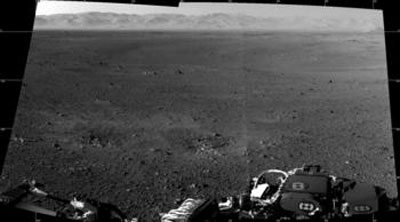| Aug 10, 2012 |
Keeping up with Curiosity
|
|
(Nanowerk News) When Curiosity touched down safely on Mars on August 5, John Grotzinger, the mission's chief scientist and the Fletcher Jones Professor of Geology at Caltech, was given the "keys" to the car-sized rover.
|
|
Since then, most of Curiosity's time has been taken up by a series of checkouts to make sure her instruments, antennae, and subsystems are working properly. But the rover has been able to take some scientific measurements of the radiation environment and of the temperature on Mars, for example. And she has relayed hundreds of images back to Earth, giving the science team plenty to study and discuss.
|
 |
| This image shows two full-resolution photos from Curiosity's navigation camera, stitched together. The rim of Gale Crater can be seen in the distance. The foreground shows two distinct zones of excavation likely carved out by blasts from the rover's descent stage thrusters. (Image: NASA/JPL-Caltech)
|
|
On Wednesday, the team shared two stitched-together full-resolution images taken by the rover's navigation camera. Part of the rover's deck is visible in the foreground, with its low-gain antenna clearly sticking up. In the distance, the rim of Gale Crater—the ancient impact crater in which Curiosity landed—appears almost like rippling mountains.
|
|
Describing the image during a press conference, Grotzinger said the science team had been struck by how Earthlike the landscape appeared. "You would really be forgiven for thinking that NASA was trying to pull a fast one on you, and we actually put a rover out in the Mojave Desert and took a picture," he said, adding that it almost looked as though some Los Angeles smog was adding a haze.
|
|
The team had also zoomed in to take a closer look at a spot where the thrusters on the rover's descent stage had blown away the soil, revealing what Grotzinger said looked to be exposed bedrock. With such interesting nearby potential targets, Grotzinger said the core of the science team's discussions had been whether to begin using Curiosity's sampling tools and instruments right there or to first drive somewhere else once they have that capability.
|

